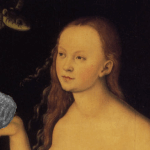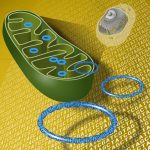Table of Contents
Mitochondrial DNA Definition
noun
plural: mitochondrial DNAs
The genetic material in the mitochondrion that carries code for the manufacturing of RNAs and proteins essential to the various functions of the mitochondrion
Variant: mitochondrial deoxyribonucleic acid. Abbreviations: mtDNA; mDNA.
Overview
Mitochondrial DNA is the DNA present in the organelle mitochondrion. It is one of the extranuclear DNA in eukaryotes. Another DNA that occurs outside the nucleus is the chloroplast DNA, which in turn occurs in the chloroplast. Similar to the nuclear DNA, the extranuclear DNA such as mitochondrial DNA is an organic compound made up of linear chains of monomeric nucleotides. Each nucleotide component, in turn, is made up of phosphate group, deoxyribose sugar, and nitrogenous base. DNAs are involved in the preservation, replication, and expression of hereditary information.
History and Terminology
The discovery of mitochondrial DNA is credited to Margit M. K. Nass and Sylvan Nass. By electron microscopy, they found the nucleic acid inside the chick embryo mitochondria. They published their findings in The Journal of Cell Biology in 19631. The following year, an independent research team published a similar finding; they found an extranuclear DNA in the mitochondria of yeasts2. Since the extranuclear DNA was found in the mitochondrion, this nucleic acid was eventually referred to as mitochondrial DNA (mtDNA) to identify it from the DNA in the nucleus.
Structure and Characteristics
The mitochondrial DNA is genetically distinct from that in the nucleus. The entire genetic information in mitochondria is called the mitochondrial genome or mitogenome. In most multicellular eukaryotes, the mitogenome is organized as a circular DNA whereas in most unicellular eukaryotes the mitogenome is organized as a linear DNA. In mammals, the mitochondrial DNA is a double-stranded circular DNA. One of the two strands is rich in guanine and is referred to as the heavy strand (or H-strand). The other strand is rich in cytosine and is referred to as the light strand (or L-strand). The H-strand is known to encode 9 genes whereas the L-strand encodes 28 genes, thus, for a total of 37 genes. The mammalian mitogenome codes for 13 proteins, 22 tRNA, and 2 for rRNA. Since a mitochondrion has its own genetic material and is capable of manufacturing its own RNAs and proteins, it is said to be a semi-autonomous, self-reproducing cytoplasmic structure.
Mitochondrial DNA vs. Chloroplast DNA vs. Nuclear DNA
Both mtDNA and cpDNA are extranuclear DNA. They are semi-autonomous, self-reproducing cytoplasmic structure, with their own genetic system. Both of them are believed to be maternally-inherited and have endosymbiotic origins. In most multicellular cells, both cpDNA and mtDNA are organized as a circular DNA, similar to the prokaryotic DNA, thus, supporting the theory of endosymbiosis. cpDNA, though, is larger and more complex than mtDNA.3 cpDNA has about 120 genes whereas mtDNA has about 37 genes. Both of them encode for proteins and RNAs vital to their functions. For instance, mtDNA encodes for proteins of electron transport chain involved in aerobic respiration (ATP synthesis). cpDNA, in turn, encodes for proteins essential to photosynthesis.
Contrary to the nuclear DNA, both mtDNA and cpDNA occur in multiple copies since there are several chloroplasts and mitochondria occurring inside a cell. A cell often contains thousands of copies of mtDNA and cpDNA. Nuclear DNAs are compacted into chromatin structures through histones. During mitosis and meiosis, mitochondria and chloroplasts randomly segregate. Thus, their genetic material segregates randomly as well into new daughter cells. 4
Mitochondrial DNA Inheritance
The mitochondrion (plural: mitochondria) is an organelle that is known as the powerhouse of the cell. It is because it is the organelle that generates most of the cell’s supply of adenosine triphosphate (ATP) through the process of cellular respiration. The mitochondrion has outer and inner membranes. The space within the inner membrane is referred to as the mitochondrial matrix. The matrix contains enzymes, mitoribosomes, and genetic material, i.e. tRNA and DNA. Unlike nuclear DNA that is inherited from both parents, the mtDNA is inherited chiefly from the mother’s ovum. Nevertheless, there were certain cases of paternal inheritance of the mitochondrial genome in humans that were described5. The rare condition in which the mitogenomes from both parents are inherited is referred to as mtDNA heteroplasmy. But in most cases, the mtDNA of an offspring is of maternal origin. The sperm cell does have mitochondria in its mid-piece. These mitochondria power up the flagellum as the sperm cell swims its way to the ovum. At fertilization though, the sperm leaves off its midpiece and flagellum while its head containing the nuclear DNA penetrates the ovum. The sperm’s plasma membrane fuses with the ovum’s plasma membrane. This allows the paternal nuclear DNA to unite with the nuclear DNA of the ovum. Consequently, the ovum’s mitochondrial DNA would then be acquired by the developing zygote.
Mitochondrial inheritance is a non-Mendelian, meaning it does not conform to the Mendelian laws of inheritance. In general, the human ovum has an average of 200,000 mtDNA molecules. Mutations in the mitochondrial DNA could lead to genetic disorders called mitochondrial diseases.
Common Biological Reactions
DNA Replication
DNA replication is a process whereby the original (parent) strands of DNA in the double helix are separated and each one is copied to produce a new (daughter) strand. Similar to nuclear DNA replication, the process is semi-conservative since one of each parent strand is conserved and remains intact after replication has taken place. DNA polymerases are also involved. Other proteins involved during the replication of mitochondrial DNA are Twinkle (which is a helicase encoded by the TWNK gene) and mitochondrial SSB proteins. These proteins, though, are encoded by the nuclear genes. Thus, mitochondrial replication is controlled by nuclear genes.
Transcription
DNA carries the genetic information that codes for a particular protein. Thus, during protein translation, the genetic code for a protein is first copied into the RNA (specifically, mRNA). This process of creating a copy of DNA into mRNA through the help of the enzyme RNA polymerase is called transcription. In mitochondrial transcription in humans, it is initiated from the three promoters: Heavy strand 1 promoter, heavy strand 2 promoter, and light strand promoter. Transcription on the heavy strand produces a polycistronic mRNA, which is a type of mRNA that encodes for more than one polypeptide in the same RNA molecule. The types of proteins that initiate mitochondrial transcription are: mitochondrial RNA polymerase (POLRMT), mitochondrial transcription factor A (TFAM), mitochondrial transcription factors B1 (TFB1M), and mitochondrial transcription factors B2 (TFB2M). POLRMT, TFAM, and TFB1M (or TFB2M) begin transcription at the mitochondrial promoters.
MtDNA Repair
Changes in the nucleotide sequence in the nuclear DNA are repaired by two major modes: (1) by the direct reversal of the chemical process that caused the damage and (2) by the replacement of damaged nitrogenous bases. In the mitochondrial DNA repair, a unique mechanism is suggested. MtDNA integrity is maintained through the degradation of excessively damaged genomes followed by the replication of an intact mtDNA.6
Mitochondrial Diseases and Disorders
Deletions and mutations in the mtDNA are largely due to the susceptibility of the nucleic acid to free radicals. The resulting proteins result in further radical formation. In due course, this could lead to age-related degenerative diseases, such as coronary artery disease, Parkinson’s disease, Alzheimer’s disease, etc. There are also cases where dysfunctional mtDNA is inherited and causes mitochondrial diseases. Examples of mitochondrial diseases are as follows:
- mitochondrial myopathy
- diabetes mellitus and deafness (DAD)
- Leber hereditary optic neuropathy (LHON)
- Leigh syndrome
- Neuropathy, ataxia, retinitis pigmentosa, and ptosis (NARP)
- Myoneurogenic gastrointestinal encephalopathy (MNGIE)
- Myoclonic Epilepsy with Ragged Red Fibers (MERRF)
- Mitochondrial myopathy, encephalomyopathy, lactic acidosis, stroke-like symptoms (MELAS)
- Mitochondrial neurogastrointestinal encephalomyopathy (MNGIE)
Biological Function
MtDNA encodes for proteins essential to proper metabolism. For instance, it encodes for the proteins in the electron transport chain, such as NADH dehydrogenase, cytochrome b, cytochrome c oxidase, and ATP synthase). The human mtDNA encodes for a micropeptide humanin, which when synthesized inside the mitochondrion is encoded by the MT-RNR2 gene and 21 amino acids long. The mitogenome also encodes for 12S rRNA and 16S rRNA, specifically by the MT-RNR1 gene and the MT-RNR2 gene in the L-strand, respectively. Mitogenome also encodes for tRNAs.
Mitochondrial Eve
The theory of Mitochondrial Eve is based on the exclusivity of human mitochondrial DNA inheritance to the female line, which when traced would lead to only one most recent woman, “Eve”. The theory is based on the exclusivity of human mitochondrial DNA inheritance to female line.7 This theory is the basis why it has become important in anthropology and biogeography. It depicts the relatedness of populations.
Research
The study of the genetics of human mitochondrial DNA is referred to as the human mitochondrial genetics. It intends chiefly to identify the genes and their functions. It also aims to understand the pathobiology of mitochondrial diseases due to mitogenome dysfunctions and thereby present potential novel mechanisms to treat or prevent such conditions. In forensics, mtDNA is used to help establish the identity of an individual.
See also
Reference
- Nass, M. M. K. &Nass, S. (1963). “Intramirochondrial Fibers With DNA Characteristics: I. Fixation and Electron Staining Reactions”. The Journal of Cell Biology 19 (3): 593–611. doi:10.1083/jcb.19.3.593.
- Schatz, G., Haslbrunner, E., & Tuppy, H. (1964). “Deoxyribonucleic acid associated with yeast mitochondria”. Biochemical and Biophysical Research Communications 15(2): 127–32. doi:10.1016/0006-291X(64)90311-0
- Cooper, G. M. (2015). Chloroplasts and Other Plastids. Retrieved from ://www.ncbi.nlm.nih.gov/books/NBK9905/
- Inheritance of mitochondrial and chloroplast DNA. (2019). Retrieved from ://www.khanacademy.org/science/biology/classical-genetics/sex-linkage-non-nuclear-chromosomal-mutations/a/mitochondrial-and-chloroplast-dna-inheritance
- Schwartz, M. & Vissing, J. (2002). “Paternal Inheritance of Mitochondrial DNA”. New England Journal of Medicine. 347 (8): 576–580.
- Alexeyev, M., Shokolenko, I,; Wilson, G., & Ledoux, S. (2013). “The Maintenance of Mitochondrial DNA Integrity – Critical Analysis and Update”. Cold Spring Harbor Perspectives in Biology, 5 (5): a012641. doi:10.1101/cshperspect.a012641.
- Gonzaga, M. V. (2018, December 9). Mitochondrial DNA not just from moms but also from dads? – Biology Blog & Dictionary Online. Retrieved from ://www.biologyonline.com/mitochondrial-dna-dads/
© Biology Online. Content provided and moderated by Biology Online Editors






